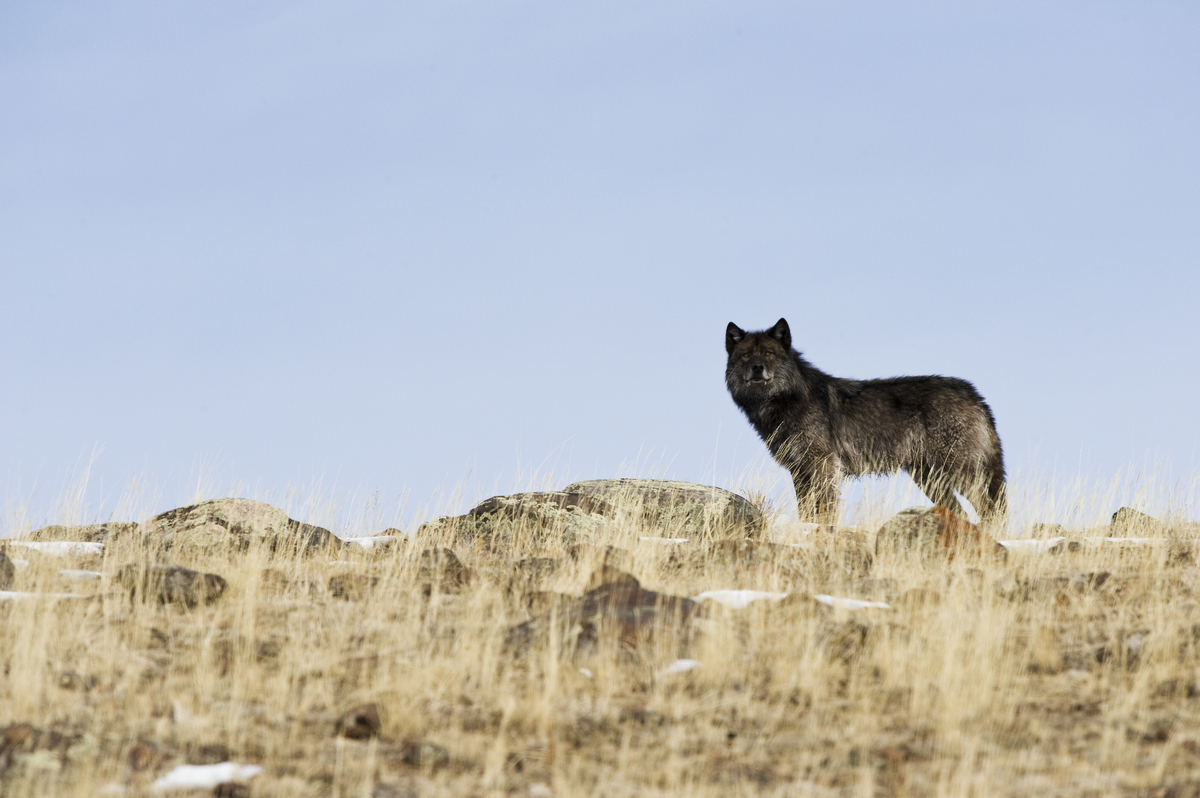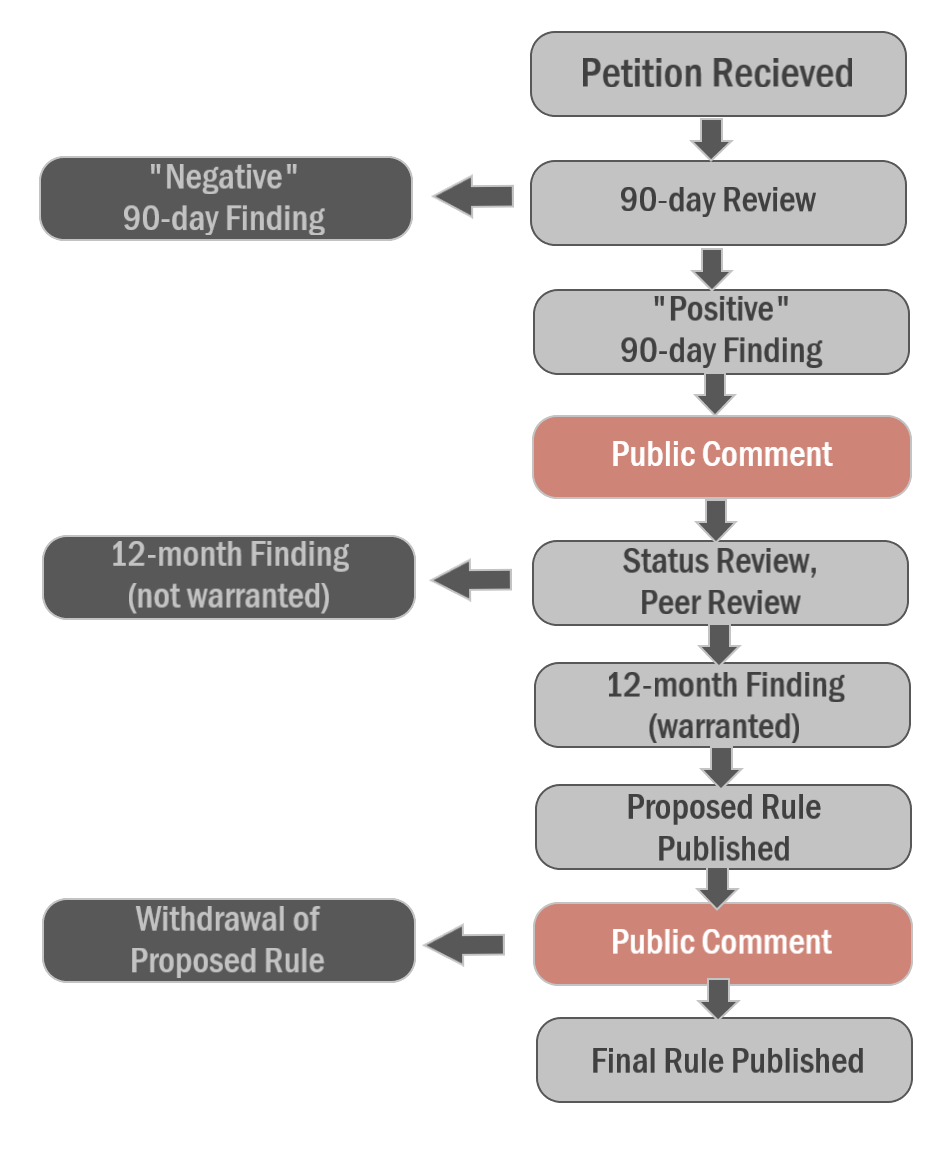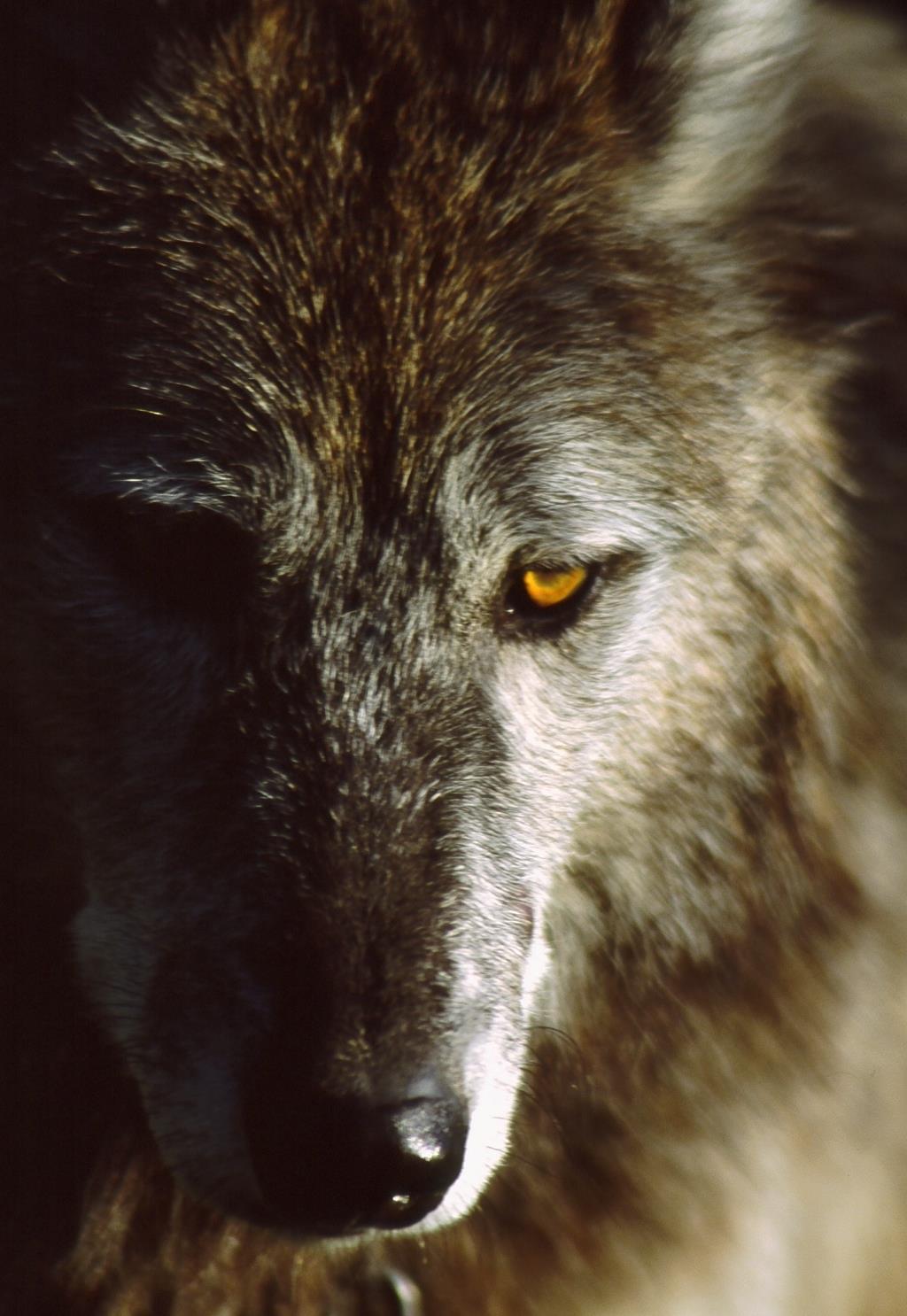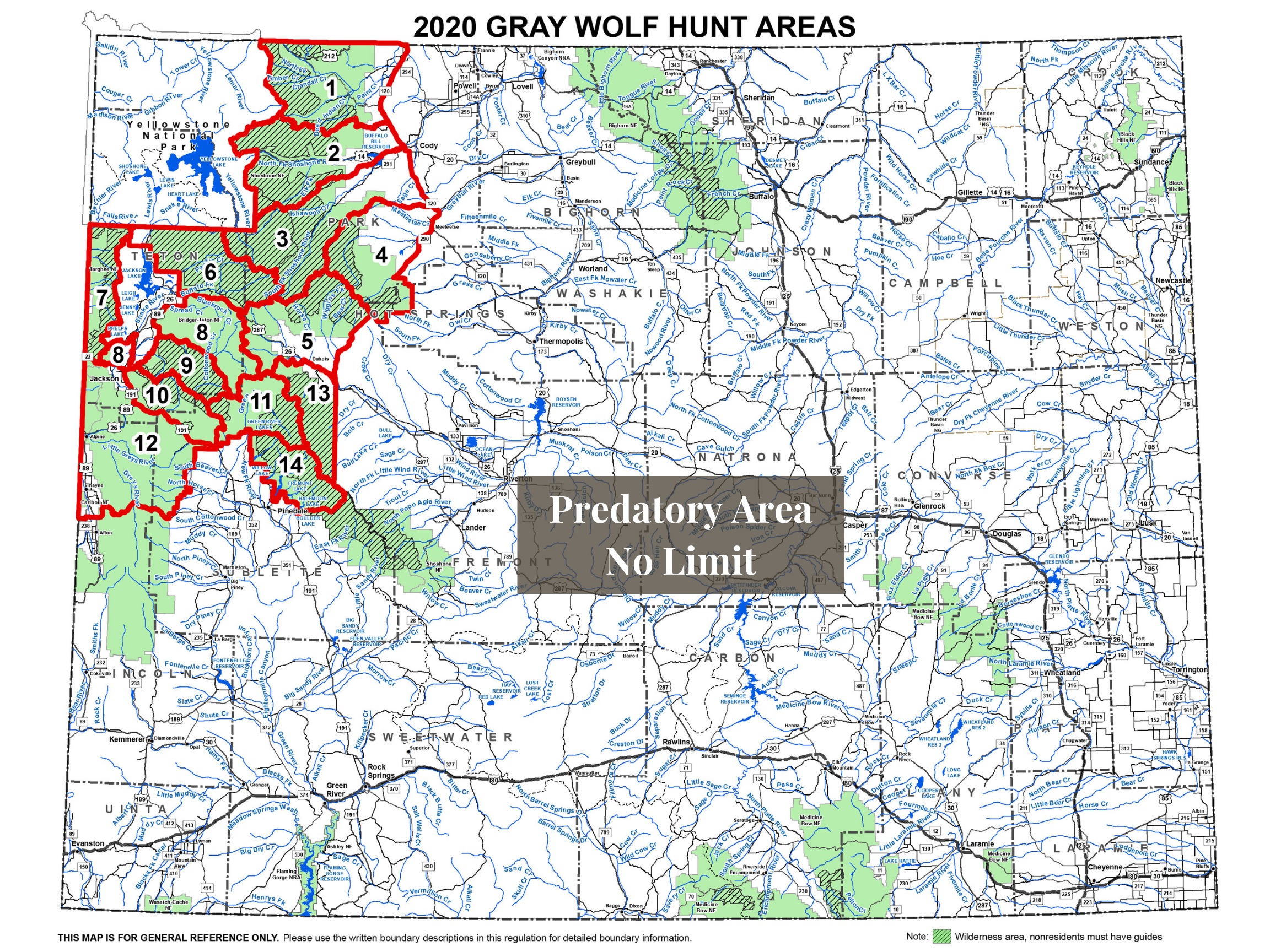
ESA Status Review Process
The status review involves collecting and analyzing scientific data, commercial information, and public comments about western gray wolves, including their biology, ecology, abundance, population trends, and threats to the species. This information is necessary to evaluate the status and extinction risk of the Western Distinct Population Segment (DPS) gray wolf population.
The ESA defines an endangered species as a species that is “in danger of extinction throughout all or a significant portion of its range,” and a “threatened species” as a species that is “likely to become an endangered species within the foreseeable future throughout all or a significant portion of its range.”
Wolves in the West Need Your Voice!
U.S. Fish and Wildlife Service Initiates Status Review of Gray Wolves in the Western U.S.
Upon reviewing two petitions filed to list the gray wolf in the western U.S. as threatened or endangered under the Endangered Species Act (ESA), the U.S. Fish and Wildlife Service (USFWS) found the petitions presented substantial credible information indicating listing action may be warranted.
. Notification of petition findings and initiation of status reviews were issued on September 17, 2021.
. Western Watersheds Project Petition
. Center for Biological Diversity and The Humane Society of the U.S. Petition
What does this mean?
The USFWS will initiate a comprehensive status review to determine whether the petitioned actions are warranted.
“To ensure that the status review is comprehensive, we are requesting scientific and commercial data and other information regarding the species and factors that may affect its status. Based on the status review, we will issue a 12-month petition finding, which will address whether or not the petitioned actions are warranted, in accordance with the Act.” FWS-R6-ES-2021-0106
How Will The Western DPS of Gray Wolves Be Evaluated?
The USFWS must determine whether the Western DPS of gray wolves is “endangered” or “threatened” because of any of the following factors:
- The present or threatened destruction, modification, or curtailment of its habitat or range;
- Overutilization for commercial, recreational, scientific, or educational purposes;
- Disease or predation;
- The inadequacy of existing regulatory mechanisms; or
- Other natural or manmade factors affecting its continued existence.
USFWS determined the claim that the Western DPS gray wolf population is at risk due to overutilization from human-caused mortality in Idaho and Montana was credible and justified review. This is in response to recently enacted legislation in Idaho (Senate Bill 1211) and Montana (Senate Bills 267 and 314; House Bills 224 and 225). Meaning the USFWS will review this specific factor when making their determination.
“Idaho Senate Bill 1211 expands means of take to include: trapping and snaring on private property year-round, hunting from all-terrain vehicles, baiting, night hunting, no bag limit, hiring of private contractors, and increased funding to the Idaho Wolf Depredation Control Board.
The Montana bills include measures such as increased bag limits, use of baits, hunting on private land at night, using artificial light or night vision, expanding the trapping season by four weeks, permitting the use of snares, and reimbursements for costs incurred in hunting and trapping wolves.” FWS-R6-ES-2021-0106


HOW YOU CAN HELP!
The USFWS is now accepting public comments. Comments should be credible and science-based. The service is interested in gray wolf biology, ecology, abundance, population trends, and threats to the species to make their determination.
Writing Tips
- Wolf observations (presence and absence) will be useful and should include approximate date and location.
- Use Western DPS or Northern Rocky Mountain DPS of wolves when referring to the listing petition.
- Remember the USFWS is making a determination based on overutilization from human-caused mortality. Try to speak to this topic specifically and how this factor is impacting or has the potential to impact the wolves of the west.
- Use Wyoming wolf management as an example of how no wolves can survive in the predator zone, where regulations are lax and human caused mortality is guaranteed.
- Review the Wyoming Untrapped public comment and findings for inspiration.
PUBLIC COMMENTS can be submitted to the USFWS by following the process outlined.
Contact The Honorable Deb Haaland, Secretary of Interior
(202) 208-3100
email feedback@ios.doi.gov
DOI contact page
Contact Martha Williams, Principal Deputy Director of USFWS
(800) 344-9453
USFWS contact page
What the Future of Western Wolves Looks Like
Wolves: Persecuted in the predator zone
Currently, in Wyoming, trapping is restricted in the Trophy Game State Wide (TGSW) zone – the NW 15% of the state. The predator zone in the rest of the 85% of the state designates wolves as predators that can be killed on sight in any manner. They have no value and are not counted in the total number of wolves. Regulations require reporting a wolf harvest within 10 days, name and address, the date the wolf killed, the sex of the wolf, and the location killed.
A trapping license is not required, but all traps in Wyoming are required to have an ID tag.
Section 8. Take of Wolves Designated as Predatory Animals.
(a) Any person who takes a gray wolf designated as a predatory animal as set forth in Section
4(a) shall be required to report the kill to a district game warden, district wildlife biologist or Department personnel at a Game and Fish Department Regional Office within ten (10) days after the date the gray wolf was killed. The person shall be required to provide their name and address, the date the gray wolf was killed, the sex of the gray wolf and the location of the site of kill (identified by the section, range and township, or UTM coordinates). In addition, 47-7 the Department may request the person to voluntarily provide a genetics sample from the gray wolf for testing to assess genetic connectivity.
(b) Surrender of electronic radio tracking devices. Any person taking a gray wolf designated as a predatory animal as set forth in Section 4(a) wearing an electronic radio tracking device shall surrender the device to the Department when registering a gray wolf in accordance with registration dates in Section 8(a).

Wolves reported taken in the Predator Zone 2012-2021, WGFD and Wildlife Services
2012: 38 wolves, 10 wolves trapped, 28 firearms
2013: 45 wolves, 14 trapped, 31 firearms
2014: 27 wolves, 4 wolves trapped, 27 firearms
2015: 52 wolves, 0 trapped, 49 firearms, 3 calling device
2016: 103 wolves, 0 trapped, 77 firearms, 26 calling device
2017: 55 wolves, 5 trapped, 50 firearms
2018: 63 wolves, 16 trapped, 47 firearms
2019: 19 wolves, 3 wolves trapped, 17 firearms
2020: 34 wolves, 5 trapped, 29 firearms
TOTAL:
437 wolves, Firearms 351, Wildlife Services: traps 25 and snares 1, calling devices 29, WGFD: traps 31
*Note: “Firearms” includes control-action from Ground, Fixed Wing Aircraft and Helicopters
**Trophy Game Wolf harvest is not included
History of wolf management in Wyoming – a short summary
The gray wolf is one of North America’s most iconic native predators. The wolf’s incredible comeback in the Northern Rockies is one of our country’s greatest wildlife success stories.
Explore the history of the Northern Rockies gray wolves, beginning in the 1930s when their numbers were decimated after years of persecution, through their successful reintroduction in the 1990s, to the current day’s first legal wolf hunts in the Northern Rockies in nearly a century. The abbreviated summary follows or read here for the full timeline.
- 1933 Wolf Population Decimated – Bounty hunters finish killing most wolves in the continental United States. Tiny remnant populations cling to existence in several spots along the Canadian border in Michigan, Montana, and Idaho. Reports of ghost wolf sightings trickle in from parts of Wyoming, Washington, and Idaho.
- 1973 Endangered Species Act Becomes Law – The Endangered Species Act (ESA) is signed into law by President Nixon. It prohibits the “taking,” without explicit permission, of species deemed to be in danger of going extinct. “Taking,” in this instance, means killing, harassing, or damaging habitat necessary for the survival and recovery of the species.
- 1974 Wolves Listed as “endangered” Under Endangered Species Act – As part of the first list of species to receive federal protections, gray wolves are listed as “endangered” under the ESA. The designation applies to all remaining wolf populations in the lower-48 states.
- 1995 Reintroduction Begins – The U.S. Fish & Wildlife Service (FWS) begins reintroducing gray wolves to central Idaho and Yellowstone. Wolves are brought in from Canada.
- 2004 State Management Plans: Idaho, Montana, Wyoming – FWS accepts Montana’s and Idaho’s proposed management plans for wolves but rejects Wyoming’s. The State of Wyoming, livestock and hunting interests supported plans to manage wolves as “predators,” which would permit indiscriminate killing in nearly 90% of Wyoming.
- 2004 Wyoming Files Suit The State of Wyoming and 28 Wyoming-based livestock and hunting groups file suit, challenging FWS’s rejection of the Wyoming management plan.
- March 2005 Wyoming Loses in District Court; Appeals – Federal District Court Judge Alan B. Johnson tosses out the lawsuit filed by the State of Wyoming and livestock and hunting interests challenging FWS’s rejection of Wyoming’s management plan. The case is ultimately appealed to the 10th Circuit.
- April 2009 Northern Rockies Wolves Delisted Again – Wolves in the Northern Rockies are again removed from the endangered species list. The delisting rule goes into effect on May 4, 2009. With the exception of Wyoming, where wolves remain federally protected, states will take over management of their wolf populations.
- August 31, 2012 Wolves Delisted in Wyoming – FWS announces it is eliminating federal protections for Wyoming’s wolves handing wolf management over to Wyoming, which will open almost all of the state to immediate, unconditional wolf killing. Wyoming’s wolf population is estimated to be only 328 wolves, far fewer than either Idaho or Montana.
- September 23, 2014 Protections Reinstated for Wyoming Wolves – A ruling from Federal District Court Judge Amy Jackson invalidated the statewide delisting of wolves in Wyoming, reinstating protections for the species. Earthjustice represented Defenders of Wildlife, Natural Resources Defense Council, the Sierra Club, and the Center for Biological Diversity in challenging the FWS’s decision to strip Endangered Species Act protections from gray wolves in Wyoming. 219 wolves were killed under Wyoming’s management since the 2012 delisting.
- April 25, 2017 Wolves Delisted in Wyoming – The U.S. Fish and Wildlife Service hands wolf management authority over tot the State of Wyoming, despite state policies that promote unlimited wolf-killing across more than 80% of Wyoming and provide inadequate protections for wolves in the remainder.
- A look ahead – May 1, 2022 – Wyoming Game and Fish Department’s five-year wolf management obligations will end, and the final management will be in their hands. Wyoming made certain commitments to obtain federal wolf delisting by FWS and if Wyoming violates those commitments the remedy is for FWS to re-list the wolves.
Learn more about Wyoming Untrapped.
Additional information can be found here…



Sawyer Claussen
Relist wolves!
Denise Tushingham
Wyoming needs natural predators to keep a healthy biodiverse landscape. Wolves should not be killed. Include them in ESA!
Dave Wipper
I did a cattle predation study in 2012 when I lived in Jackson. Based on the nass.usda.gov/Statistics_by_State/Wyoming/Publications/Annual_Statistical_Bulletin/bulletin2013, 84% of cattle deaths occurred due to lameness/injury, disease, non-predator, old age, digestive problems, calving, respiratory problems, and weather-related causes; less than 5% was due to wolves, yet wolves are reviled. I understand that hunters and outfitters enjoy hunting elk and that ranchers do not want to lose cattle (or sheep), but losses to trophy animals and livestock cannot be completely blamed on wolves. Perhaps if there were less hunters and ranchers on our public lands, coexistence with wolves and nature could become a reality.
Stafanya
Humans do not understand nature well enough to be the ones to make decisions to cull predators. Over hunting combined with loss of habitat has created the problem. Stop killing before it’s too late.
Raquel West
Please stop killing these animals. The circle of life is nature – nature belongs in this world. We are losing more and more of it every day.
Stop the slaughterhouse mentality.
They are magnificent creatures like our wild . Leave them be !
#onlyfootprints
Vulupus
Please relist them, relist the wolves!
Wolves never did anything wrong! If you guys think that Wolves are dangerous to humans, that’s false; wolves almost never attacked humans & they’re always trying to stay away from human population most of the time! But despicable, GREEDY humans are the ones who keep coming after them & attacking them!
Plus, Quit using biased excuses like “but we need to control Wolves population to protect the herbivores”! The one who needs to be controlled here are the humans who keep slaughtering them for their selfish desire!! Wolves are also very important to keep elks, mooses & other herbivores population balanced!
And also, human doesn’t need wolf’s pelt/fur to make your warm clothes when you already have sheeps, alpacas, & artificial fur thanks to our modern technology! We’re not in ice age anymore, this is 2021!
Stop killing before it’s too late!
#RELISTWOLVES
Carol Bordin
I’ll be commenting! We Need To RisE uP for Our Wolves! All this Evil Wicked Scheming By Man Has to Stop! God does NOT Condone all This Killing of His Creation, His Wolves!
Frances
I was told by a Fish and Game officer that while ranchers are repaid for predation against their livestock, no one really knows for certain who killed the animals – no DNA testing is done, no real investigation and this was after a massive livestock slaughter attributed to wolves in an area of Wyoming that claims there are no wolves. The officer I spoke with is higher up the command chain and has been in the F&G service for decades and covers a large area. Since we live in a world where people do all sorts of unlawful and immoral things, it is completely plausible the livestock were killed and made it to look like wolves. I brought this up to the officer and he said that is always a possibility, but they go ahead and report what the rancher tells them. I imagine a whole Pandora’s box would be opened if they questioned and did a real investigation into the claims. I also think it would be worth time to check livestock predation claims against beef and sheep sale prices. It would pay the rancher more money to make a wolf, bear or lion attack than take to a weak market.
Madis Marissa
Wolves are essential keystone apex predators that heal the land, prevent natural disasters and keep themselves, other wildlife, ecosystems and the environment in check. Wolves are the only ones who can stop the chronic wasting disease spreading throughout the herds of deer. There are plenty of non-lethal methods to keep wolves at bay. A great one would be removing livestock from wildlife land. Stop slaughtering and massacring our wolves. Wolves are needed, check the science and proven facts. There’s no reason whatsoever to hunt Wolves. Trophy hunting and trapping is sadistic, pathetic, bloodthirsty, and has no place in today’s society. More than half of the world is against the eradication of our wolves and other predators, as well as trophy hunters and trappers. Even ethical hunters are against it. #RelisttheWolvesNOW #StoptheWaronWolves #Wolveslivesmatter #WildlifeNOTLivestock #GovernbyScienceandProvenFacts
Johnson Marcie
Please stop killing our native wolves we need them for the ecosystem and you are destroying them. They deserve to live there in peace. Stop the killing NOW!!!
Julia Freund
We have not been very good to wolves in history and we need to do much better than what we are attempting to do now. I’m shocked how trapping and other heinous means are even allowed. Especially on our public lands. Please end this war on apex predators.
Elizabeth Bachtle
How evil the actions against these precious resources on this earth! Wolves are very important creatures to this earths eco system! Please protect these innocent lives!
Margie Key
We all need our wolves please leave them alone and let them rebuild their packs and help the Park!
WY MAX? – Trapping Reform in Wyoming
[…] Today we remember Max and all the wolves that have died needlessly since. We urge you to speak up for the wolves in the Northern Rockies and demand their protection too! […]